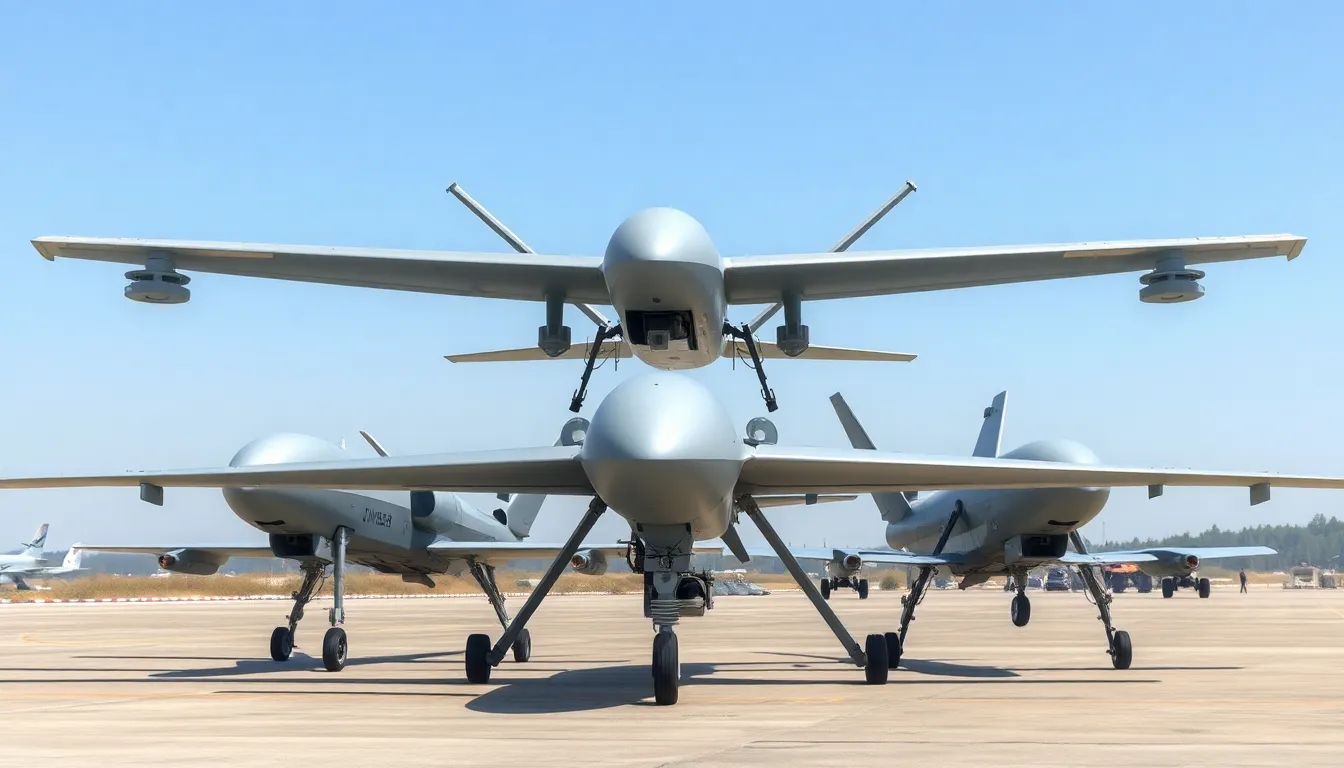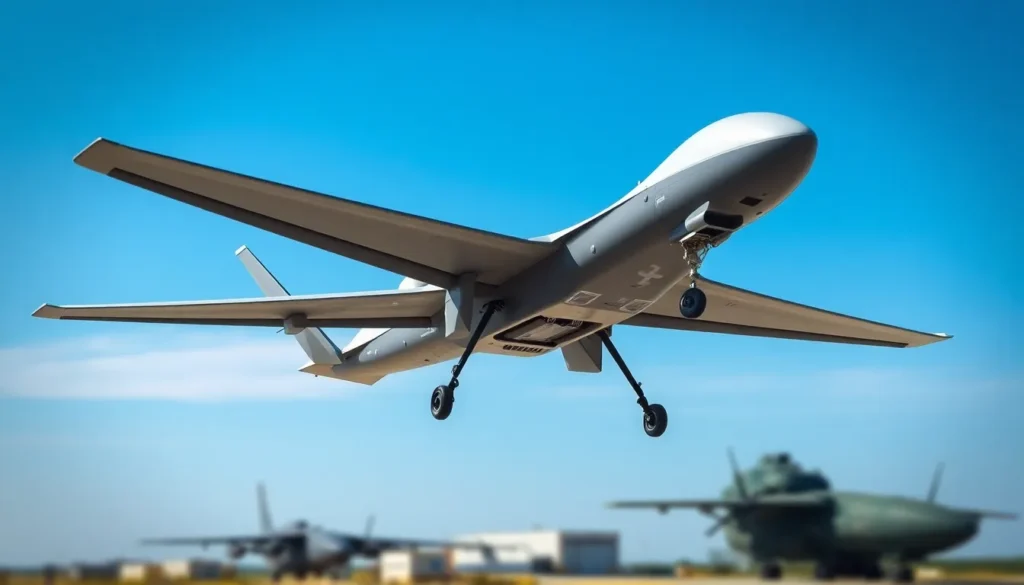Table of Contents
ToggleIn the realm of military technology, Chinese military drones are soaring to new heights—literally and figuratively. These high-flying marvels are not just toys for tech enthusiasts; they’re reshaping the landscape of modern warfare. With their impressive capabilities and advanced features, it’s no wonder that these drones have become the talk of defense circles worldwide.
Overview of Chinese Military Drones
Chinese military drones display advanced technology designed for various strategic purposes. They offer capabilities in surveillance, reconnaissance, and precision strikes. The growing fleet of unmanned aerial vehicles (UAVs) enhances China’s combat effectiveness.
Drones like the Wing Loong series function as multipurpose platforms, utilized for both intelligence gathering and combat operations. Another model, the CAIC Z-10, serves as an attack helicopter drone, adding versatility to aerial missions. These drones incorporate features such as stealth technology, improving their operational efficiency.
Numerous manufacturers in China contribute to this surge in drone production. Leading companies, including Aviation Industry Corporation of China (AVIC) and Chengdu Aircraft Industry Group, drive innovation in drone systems. Investment in research and development strengthens the military’s advanced drone capabilities.
Data reveals a significant increase in drone deployments within the last few years. In 2020, China reportedly operated over 1,000 military drones, with projections indicating exponential growth by 2025. Utilization of drones in military exercises enhances real-world combat readiness.
Integration of drones in joint operations exemplifies a shift in military strategy. By coordinating drone use with traditional forces, Chinese military tactics adapt to modern challenges. Such integration reflects a comprehensive approach to warfare, highlighting the value of drones as force multipliers.
Chinese military drones are not merely technological tools; they fundamentally alter the dynamics of regional and global security. Understanding their capabilities provides insight into future military developments in Asia and beyond.
Types of Chinese Military Drones

Chinese military drones vary in function and capabilities, contributing significantly to military operations. They can be categorized into several types, including reconnaissance drones, combat drones, and target drones.
Reconnaissance Drones
Reconnaissance drones play a crucial role in intelligence-gathering missions. Models such as the ASN-209 provide real-time aerial surveillance, collecting vital data on enemy positions. These drones boast advanced sensors and imaging systems that enhance situational awareness. They assist in monitoring troop movements and strategic assets, providing commanders with actionable intelligence. Enhanced communication links ensure data transmission to ground units occurs seamlessly.
Combat Drones
Combat drones are designed for offensive operations, executing precision strikes against ground targets. The Wing Loong II exemplifies this category, featuring a payload capacity that supports guided missiles and munitions. Capable of operating in contested environments, these systems often utilize stealth technology to avoid detection. Operators can deploy them for various missions, including close air support and target elimination. A combination of speed and agility allows them to engage threats effectively while minimizing collateral damage.
Target Drones
Target drones serve specific training purposes for military personnel. Drones like the BZK-007 simulate enemy aircraft, providing realistic training scenarios for air defense units. These systems are instrumental in practicing intercept tactics and refining weapon accuracy. Equipped with advanced maneuverability, target drones challenge pilots and systems during exercises. They play a vital role in evaluating and improving military readiness by ensuring forces are prepared for real-world engagements.
Technological Advancements
Chinese military drones incorporate advanced technologies that enhance their operational capabilities and strategic value. These innovations play a vital role in modern warfare dynamics.
AI and Autonomy
AI integration enhances the decision-making process in military drones. Algorithms enable real-time data analysis, improving mission outcomes. Autonomy allows these drones to operate with minimal human intervention, maximizing efficiency in combat scenarios. Systems like the Wing Loong series employ sophisticated AI for target recognition and engagement. Manufacturers prioritize autonomous features, reducing operational risk for personnel and increasing responsiveness on the battlefield.
Stealth Features
Advanced stealth technologies enhance the survivability of Chinese military drones. Radar-absorbing materials minimize their visibility to enemy detection systems. Design features also contribute to reduced noise and heat signatures, making these drones harder to detect. Models like the CAIC Z-10 utilize innovative stealth tactics for reconnaissance and offensive operations. These stealth capabilities significantly improve effectiveness in high-risk environments.
Strategic Implications
Chinese military drones significantly influence strategic dynamics across multiple regions. Their integration into military operations reshapes power balances and operational approaches.
Regional Security Dynamics
Drones enhance surveillance capabilities in the Asia-Pacific, allowing China to monitor vast maritime areas. Key areas like the South China Sea witness increased Chinese presence through reconnaissance missions. Countries in the region respond to these developments by bolstering their defense strategies. Neighboring nations, recognizing the operational advantages of Chinese drones, may invest in countermeasures or develop their own drone technologies. The evolving landscape of drone warfare complicates traditional military engagements, prompting shifts in alliances and strategic partnerships.
Global Military Balance
Chinese military drones alter the global military balance by introducing advanced, cost-effective technology. These drones enable asymmetric warfare, allowing China to project power without overwhelming conventional forces. Nations like the United States and India scrutinize these developments, reassessing their military budgets and defense initiatives. As countries invest in counter-drone measures, the arms race in unmanned systems intensifies. Observers note that the proliferation of Chinese drones could inspire a new wave of military innovation globally, potentially revolutionizing combat strategies.
Chinese military drones are reshaping the landscape of modern warfare. Their advanced capabilities and strategic applications underscore their importance in military operations. As these drones continue to evolve with cutting-edge technology they will play an increasingly vital role in China’s defense strategy.
The implications of this drone proliferation extend beyond national borders affecting regional stability and global military dynamics. Countries are now compelled to adapt their defense strategies in response to China’s advancements. This ongoing evolution in drone technology is set to redefine the future of combat and security on a global scale.







